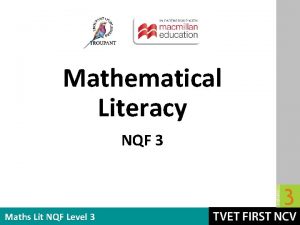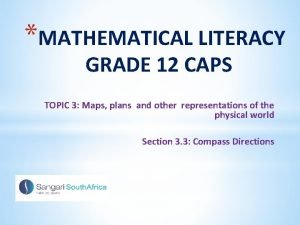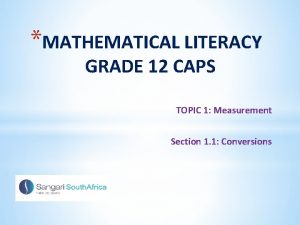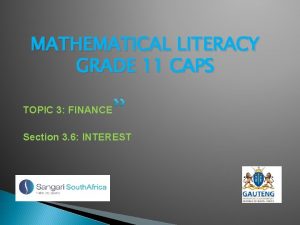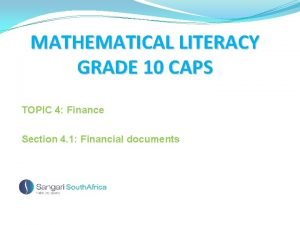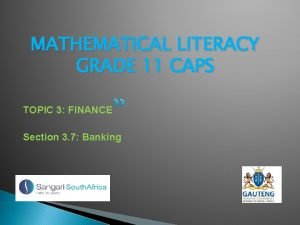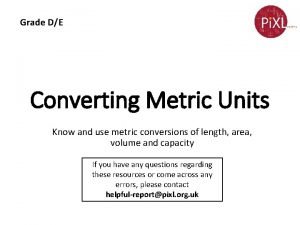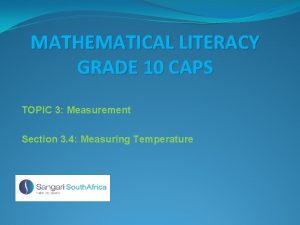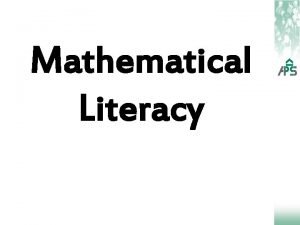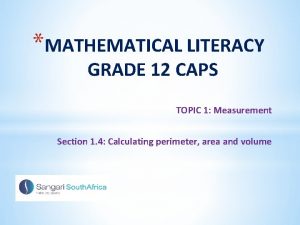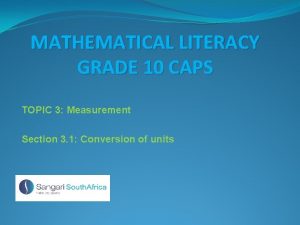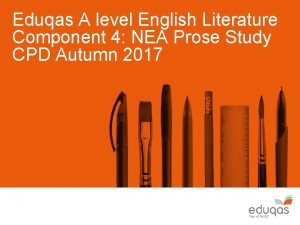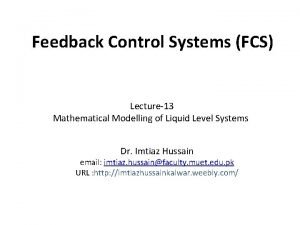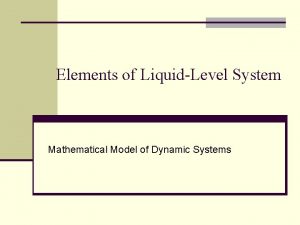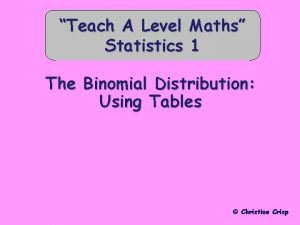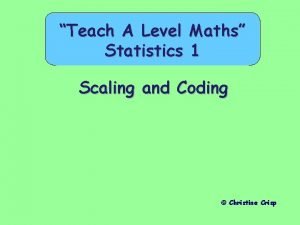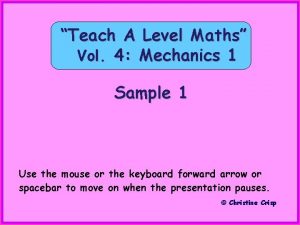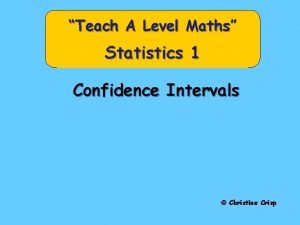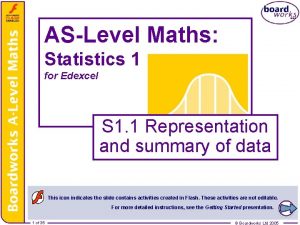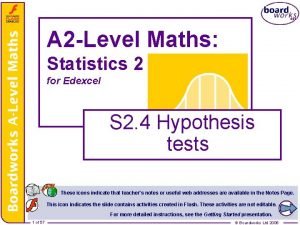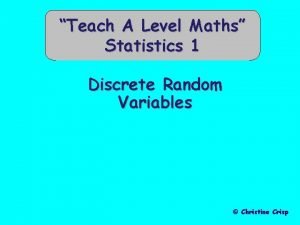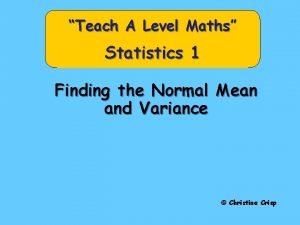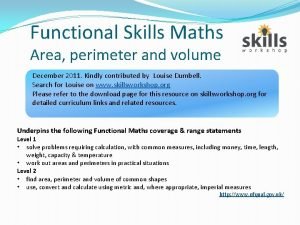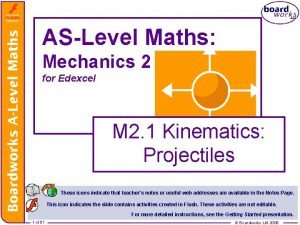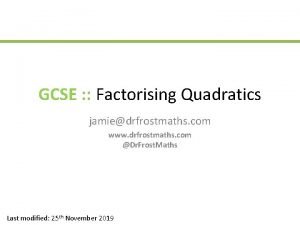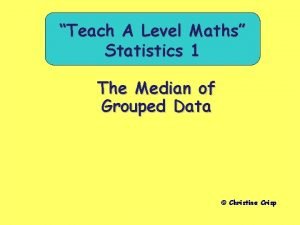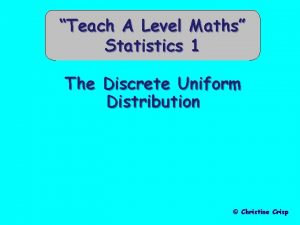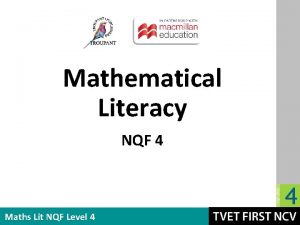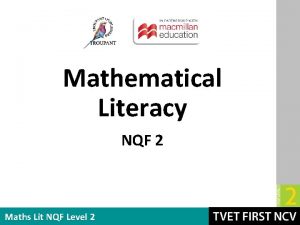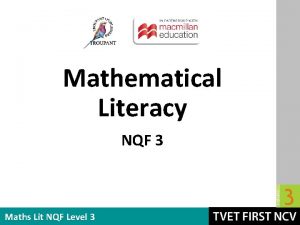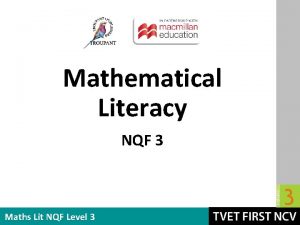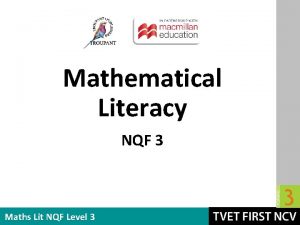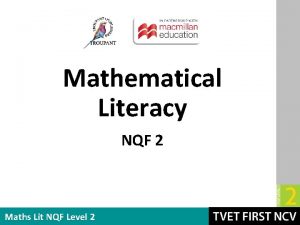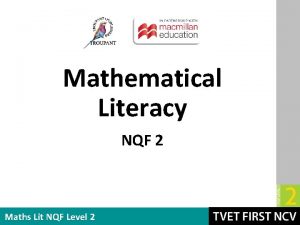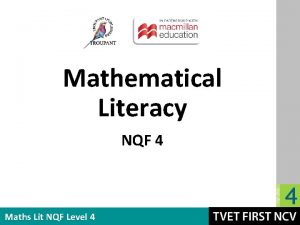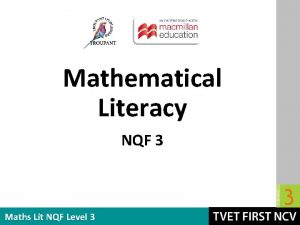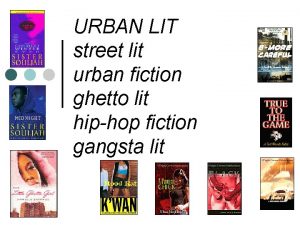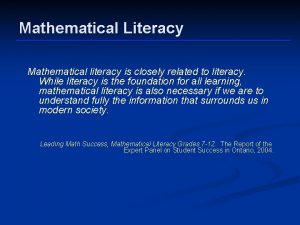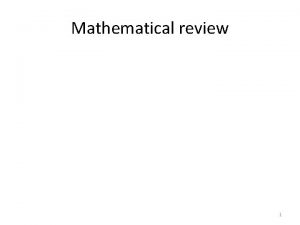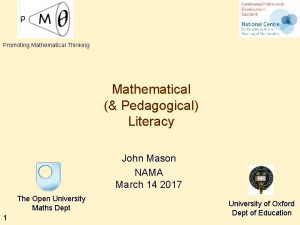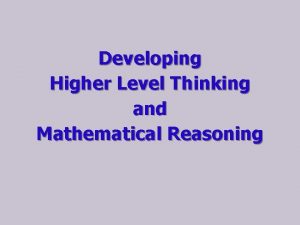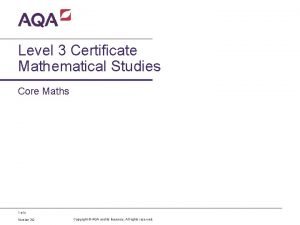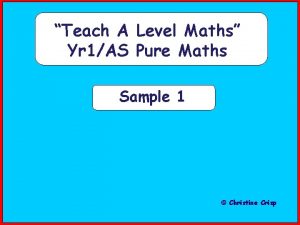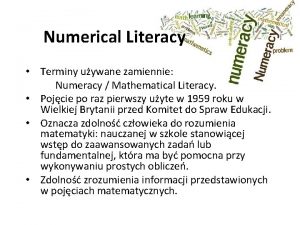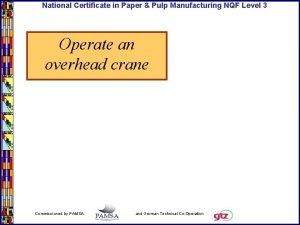Mathematical Literacy NQF 3 Maths Lit NQF Level










































- Slides: 42

Mathematical Literacy NQF 3 Maths Lit NQF Level 3

Banking in the workplace Module 11 Maths Lit NQF Level 3

Overview 11. 1 11. 2 11. 3 11. 4 Comparing bank products Bank Statements Investigating bank charges Comparing bank charges and service fees Maths Lit NQF Level 3

Comparing bank products Unit 11. 1 Banks are institutions that make it safe and easy for a business to conduct their financial affairs. Depositing cash Making payments and cash transfers Having a credit and fuel cards Maths Lit NQF Level 3 Making loans and overdrafts Investing money from business profits

Types of accounts Unit 11. 1 • Cheque or current account • Savings account • Credit card Maths Lit NQF Level 3

Choosing a bank account Unit 11. 1 • First determine what each bank has to offer. • Your choice must be based on what your banking needs are. Maths Lit NQF Level 3

Example 11. 1 page 213 Unit 11. 1 Steve owns a painting company. His main banking needs are: • electronic banking services that include Internet banking and cell phone banking • an easy way to pay when purchasing materials from the hardware store Maths Lit NQF Level 3

Example 11. 1 page 213 Unit 11. 1 • a way to monitor his work-related transport costs • a facility for customers to pay for services by electronic transfer • a short- term credit facility occasionally, for times when his expenditure is greater than his income • a savings account where he can bank some of his profit, and where he can withdraw from his account in emergencies. Steve considers the business banking options of two banks. He finds that business packages include a cheque account, a credit card and a savings facility. Maths Lit NQF Level 3

Example 11. 1 page 213 Unit 11. 1 Bank 1: Fiscal Bank 2 The Business Account is suited to • A business account with a sole proprietors. The account is debit card and cheque flexible. It offers: book • simple tools to pay for day-to • 30 electronic transactions day operations and other (transfers and payments) business transactions • Free subscriptions to • electronic (internet, cell phone), online, cell phone and ATM or face-to-face banking in telephone banking a banking hall Other benefits: • a cheque card, a credit card and • Free legal advice a petrol card • Concierge services • a savings facility with investment • Debit order switching options services • a credit card facility • An enterprise service desk • a loan facility • A there separate 1. Are any savings services • a credit card account provided by one bank that are Other benefits: • A separate credit card notaccount provided by the other? • A team of experts to offer advice based on the specific needs of 2. Which bank offers more the business attractive benefits? Give • A business banking app for reasons. tablets and smartphones • Earn rewards on cheque and credit card spending • Free software for doing business financial reports Maths Lit NQF Level 3

Example 11. 1 page 213 Unit 11. 1 1. Bank 1 offers a cheque card, credit card and petrol card. Bank 2 only offers a cheque card. Bank 1 offers a savings facility and loan facility. Bank 2 offers these as separate accounts. Bank 1 offers free software for financial reporting and invoicing. Bank 1 also offers rewards on purchases. 2. Bank 1 offers more attractive benefits. All businesses need access to financial reporting and invoicing. This is a very attractive benefit. There is also the savings and loan facility. It is convenient to have all business dealings consolidated in one package. Maths Lit NQF Level 3

Bank fees Unit 11. 1 Bank fees need to be kept to the minimum. The higher the bank costs, the higher the expenditure of a business. The higher the expenditure, the less the profit to the business. Maths Lit NQF Level 3

Exercise 11. 1 Unit 11. 1 Complete Exercise 11. 1 on page 215 of your Student’s Book Maths Lit NQF Level 3

Bank Statements Unit 11. 2 A bank statement provides the business person with a record of all the financial transactions for a given period: • all withdrawals, deposits, electronic transfers and bank fees Bank statements are issued on demand are now almost always sent electronically via email. Maths Lit NQF Level 3

Example of a typical bank statement on page 217 Unit 11. 2 Like all financial documents, bank statements have the following distinct information in their header. Name of institution Maths Lit NQF Level 3

Example of a typical bank statement on page 217 Unit 11. 2 Like all financial documents, bank statements have the following distinct information in their header. Name of account holder Maths Lit NQF Level 3

Example of a typical bank statement on page 217 Unit 11. 2 Like all financial documents, bank statements have the following distinct information in their header. Statement date Maths Lit NQF Level 3

Example of a typical bank statement on page 217 Unit 11. 2 Like all financial documents, bank statements have the following distinct information in their header. Statement period Maths Lit NQF Level 3

Example of a typical bank statement on page 217 Unit 11. 2 Like all financial documents, bank statements have the following distinct information in their header. Bank account number Maths Lit NQF Level 3

Example of a typical bank statement on page 217 Unit 11. 2 The statement has columns with the following headings: Date - is the date of the transaction Maths Lit NQF Level 3

Example of a typical bank statement on page 217 Unit 11. 2 The statement has columns with the following headings: Description – the details of the transaction Maths Lit NQF Level 3

Example of a typical bank statement on page 217 Unit 11. 2 The statement has columns with the following headings: Debits – money that is leaving the account Maths Lit NQF Level 3

Example of a typical bank statement on page 217 Unit 11. 2 The statement has columns with the following headings: Credits – money coming into the account Maths Lit NQF Level 3

Example of a typical bank statement on page 217 Unit 11. 2 The statement has columns with the following headings: Balance – the balance in the account after that specific transaction. Maths Lit NQF Level 3

Example of a typical bank statement on page 217 Unit 11. 2 The statement has columns with the following headings: Opening balance is the balance that the statement starts at. Closing Balance is the balance left after all transactions depicted on the statement have been calculated. Maths Lit NQF Level 3

Exercise 11. 2 Unit 11. 2 Complete Exercise 11. 2 on page 217 of your Student’s Book Maths Lit NQF Level 3

Investigating bank charges Unit 11. 3 • Banks offer different options for transactions. • Each option has different bank charges. • When running a business, it is important that the cheapest option is chosen. Maths Lit NQF Level 3

Example 11. 2 page 218 Unit 11. 3 Steve has done a big painting job at the Spaza Health Bar. His invoice was for R 18 450, 00. There are different ways that Steve could be paid: • Cheque • Cash • EFT Study the bank fees below, then answer the questions that follow. Maths Lit NQF Level 3

Example 11. 2 page 218 continued. . . Unit 11. 3 Transaction Fee Cheque deposit R 40, 00 Cash deposit Branch counter R 0 to R 4 999, 99: R 8, 40 + R 2, 81 per R 100 or part thereof R 5 000 to R 14 999, 99: R 8, 40 + R 1, 58 per R 100 or part R 15 000 to R 49 999, 99: R 8, 40 + R 1, 48 per R 100 or part R 50 000 and more: R 8, 40 + R 1, 25 per R 100 or part thereof R 40 minimum fee Cash deposit ATM R 3, 75 + R 0, 76 per R 100 or part thereof Electronic transfers into account Free Electronic transfers out of account R 4, 00 Cash withdrawal Maths Lit NQF Level - ATM 3 R 1, 75 + R 0, 60 per R 100 or part thereof

Example 11. 2 page 218 continued. . . Unit 11. 3 1. If Spaza Health Bar pays Steve by cheque, what would it cost Steve in bank fees? 2. a) If Spaza Health Bar pays Steve in cash, how much would it cost them to withdraw the cash at their bank? b) How much would it cost Steve to deposit this cash at the bank? 3. a) If Spaza Health Bar pays Steve by EFT, how much would it cost them to do the transaction? b) How much would it cost Steve in bank fees? Maths Lit NQF Level 3

Example 11. 2 page 218 continued. . . Unit 11. 3 4. What is the cheapest method to pay Steve? 5. Would you advise Spaza Health Shop to do a cash payment? Give reasons for your answer. 6. Which form of payment would you advise Spaza Health Shop to choose? Give reasons for your answer. Maths Lit NQF Level 3

Example 11. 2 page 218 continued. . . Unit 11. 3 1. R 40, 00 2. a) Spaza Health Bar has to pay R 18 450. The fee is R 1, 71 per R 100 or part thereof. = 190 × R 1, 71 = R 324, 90 b) Steve would pay R 8, 40 + R 1, 48 per R 100 or part thereof. R 8, 40 + () = R 8, 40 + (190 × R 1, 48) = R 8, 40 + R 281, 20 R 289, 60 3. a) R 4, 00 b) No charge 4. EFT 5. No. It carries the highest bank charges, and it would be very dangerous to transact in such a large amount of cash. 6. An EFT would be the cheapest and safest way to pay Steve. Maths Lit NQF Level 3

Exercise 11. 3 Unit 11. 3 Complete Exercise 11. 3 on page 219 of your Student’s Book Maths Lit NQF Level 3

Comparing bank charges and service fees Unit 11. 4 • Choosing the best pricing option to suit your business needs could save a considerable amount in bank chares every month. • Most banks have two options available for businesses, namely: Option 1 • A fixed monthly fee for a limited number of transactions. Option 2 • A schedule of fees for different transactions. You pay for what you use. Maths Lit NQF Level 3

Example 11. 3 page 221 Unit 11. 4 Here is a different payment structure for a bank Bank 1 – Fixed fee structure You pay a fixed fee of R 215 per month. You get: • 30 electronic debit transactions that include: • a maximum of 5 ATM cash withdrawals • cash deposits up to R 50 000 • unlimited cheque card purchases • unlimited transfers and prepaid purchase • Excess electronic debit transactions @ R 18, 00 per transaction • Excess cash deposits @ R 3, 75 + R 0, 60 per R 100, 00 or part thereof • Debit orders charged at normal rate • Petrol card payments charged at normal rate Maths Lit NQF Level 3

Example 11. 3 page 221 continued. . . Unit 11. 4 1. Calculate Steve’s bank fees if he chooses the fixed rate from Bank 1. 2. Some banks structure their fees differently. This Business Essentials package costs R 199, 00 per month. Calculate Steve’s bank fees if he chose this option. Transaction Type Electronic account payments, funds transfers and debit orders (excludes immediate interbank payments, branch transactions, as well as other transactions) Threshold Limited to 30 transactions per month Online banking Monthly subscription fee is free Out of bundle fee R 18, 00 per transaction for all payments and transfers Debit order R 18, 50 e-Statement No charge Maths Lit NQF Level 3

Example 11. 3 page 221 continued. . . Unit 11. 4 3. Steve’s bank fees are R 252, 35 when he pays for each transaction at Bank 1. You can now compare the two fee structures in this example, with the fee structure in Example 11. 1. Of the three options, which option would you advise Steve to choose? Give a reason for your answer. Maths Lit NQF Level 3

Example 11. 3 page 221 continued. . . Unit 11. 4 1. Transaction Type Threshold Total Monthly account fee R 215, 00 5 Electronic deposits 30 free transactions R 0, 00 POS withdrawals of R 500 R 18, 00 x 1 R 18, 00 4 Petrol purchases R 5, 00 × 4 R 20, 00 3 debit orders R 17, 50 × 3 R 52, 50 e-Statement Free Cash deposit at bank – R 2 000 20 POS payments 3 ATM cash withdrawals of R 1000 each 1 POS withdrawals of R 500 Total monthly fee = R 305, 50 Maths Lit NQF Level 3

Example 11. 3 page 221 continued. . . Unit 11. 4 2. Transaction Type Threshold Total Monthly account fee R 199, 00 5 Electronic deposits 30 free transactions R 0, 00 POS withdrawals of R 500 R 18, 00 4 Petrol purchases R 18, 00 × 4 R 72, 00 3 debit orders R 17, 50 × 3 R 52, 50 e-Statement No charge R 0, 00 Cash deposit at bank – R 2 000 20 POS payments 3 ATM cash withdrawals of R 1000 each 1 POS withdrawals of R 500 Total monthly fee = R 341, 50 Maths Lit NQF Level 3

Example 11. 3 page 221 continued. . . Unit 11. 4 3. I would advise him to pay for each transaction at Bank 1. I would not advise him to choose the fixed rate because his transactions make it a more expensive option. Maths Lit NQF Level 3

Exercise 11. 4 Unit 11. 4 Complete Exercise 11. 4 on page 222 of your Student’s Book Maths Lit NQF Level 3

Module assessment Module 11 Complete Module assessment on page 224 of your Student’s Book Maths Lit NQF Level 3

TERMS AND CONDITIONS This Power. Point Presentation has been developed by Macmillan Education South Africa (Pty) Ltd. All texts, images, videos, animations, audio and vector simulations contained in the slides are property of Macmillan South Africa. Reproducing, reselling and redistributing this material without the written permission of Macmillan South Africa is prohibited. Lecturers are granted permission to: (i) modify the slides by adding and removing content; (ii) print copies of the presentation; and (iii) download and save the slides to a computer or local server. Nothing in this copyright notice constitutes permission to assert or imply that your use of the materials is sponsored or endorsed by Macmillan South Africa. Maths Lit NQF Level 3
 Mathematical literacy level 3
Mathematical literacy level 3 National qualifications framework
National qualifications framework Labour intensive construction training nqf 5
Labour intensive construction training nqf 5 What is mathematical economics
What is mathematical economics Types of maps in maths lit grade 12
Types of maps in maths lit grade 12 Elevation map maths lit
Elevation map maths lit Conversions in maths lit grade 12
Conversions in maths lit grade 12 Maps, plans and other representations of the physical world
Maps, plans and other representations of the physical world Maps in maths literacy
Maps in maths literacy Finance in mathematical literacy
Finance in mathematical literacy Mathematical literacy grade 12 exchange rate
Mathematical literacy grade 12 exchange rate Water tariffs grade 11
Water tariffs grade 11 Finance in mathematical literacy
Finance in mathematical literacy Packaging mathematical literacy grade 12
Packaging mathematical literacy grade 12 Bank statement maths literacy
Bank statement maths literacy Conversions of units
Conversions of units Mathematical literacy grade 10 measurements
Mathematical literacy grade 10 measurements Difference between mathematics and mathematical literacy
Difference between mathematics and mathematical literacy Measurement maths literacy grade 12
Measurement maths literacy grade 12 Mathematical literacy grade 10 measurements
Mathematical literacy grade 10 measurements Math literacy grade 12
Math literacy grade 12 Media literacy venn diagram
Media literacy venn diagram Venn diagram of media literacy
Venn diagram of media literacy Examples of people media
Examples of people media Cyber literacy for the digital age
Cyber literacy for the digital age Nea english literature a level ideas
Nea english literature a level ideas Eduqas examiner vacancies
Eduqas examiner vacancies Mathematical model of liquid level system
Mathematical model of liquid level system Mathematical model of liquid level system
Mathematical model of liquid level system Binomial distribution a level
Binomial distribution a level A level maths coding
A level maths coding Connected particles a level maths
Connected particles a level maths What is z in confidence interval formula
What is z in confidence interval formula Progress test example
Progress test example Interpolation a level maths
Interpolation a level maths Hypothesis testing a level maths
Hypothesis testing a level maths Discrete random variable
Discrete random variable A level statistics
A level statistics Functional skills maths level 2 area and perimeter
Functional skills maths level 2 area and perimeter Projectiles a level maths
Projectiles a level maths Drfrostmaths answers
Drfrostmaths answers Median formula grouped data
Median formula grouped data Uniform distribution a level maths
Uniform distribution a level maths
